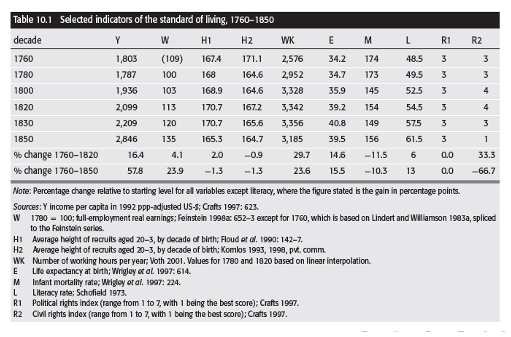
This a table showing the different indicators available to assess the standard of living of the pre-modern worker. Below are some notes I made regarding the historiography of the standards of living debate.
The Marxist view:
Marx wrote in The Communist Manifesto that The Industrial Revolution made workers the slave of the bourgeois state. Marxists tend to hold the view that agricultural workers in the 18th century were far better off than factory workers in the 19th century.
Hobsbawm was a Marxist Historian. His argument has focused around real wage data being inconclusive. He argues that if unemployment was high then this would offset rising real wages in terms of the standard of living. Furthermore, food consumption seems to have declined during The Industrial Revolution. Evidence suggests that the number of cattle and sheep slaughtered failed to keep pace with population growth and so there was a decline in food consumption. Howbsawm argues that this cannot constitute a rise in the standard of living.
The Neoliberal/Classical Liberal view:
The Neoliberal view is one that counters the Marxist view. Hartwell was a proponent of the Neoliberal approach to the standard of living debate. He countered Hobsbawm’s arguments in the following way. Firstly, it would have taken a substantial rise in unemployment to offset the rise in incomes and wages (based on Deane and Cole’s figures) that occurred during the Industrial Revolution. Secondly, Hobsbawm’s argument does not take into account the emergence of new markets for food and simply considers the ones that pre-existed prior to The Industrial Revolution. In this sense is fundamentally ignores the changes that occurred during The Industrial Revolution.
Hartwell then furthered his argument by adding that imports of luxury goods (tea, tobacco, sugar) rose. There was a rise in savings banks during the first quarter of the 19th century. The end of the Napoleonic Wars reduced prices as agriculture returned to normal and imports started to flow again.
The modern view:
By the 1980s the economists had made the debate more empirical (for better or worse) and it became one of optimism (much like Hartwell had originally argued). Lindert and Williamson proposed the view that living standards were stagnant during the initial Industrialisation period (1760-1820). But once this was completed living standards rose rapidly until the 1850s. Their evidence for this was slow wage growth during the periods immediately before, during and after the Napoleonic Wars, but rapid growth from 1819-1850 (when wages increase 110 for all workers). Thus, The Industrial Revolution brought about a combined increase in output and dramatic improvements in living standards. Wrigley and Schofield furthered this using evidence from increases in life expectancy.
Yet this changed once more when the revisionists (Crafts and Harley) triumphed over the traditionalist (Deane and Cole) in the growth figures debate in the 1990s. The debate became more pessimistic. The substantial downward revision in growth figures (and further work by Horrel and Humphries) suggested that family incomes may have failed to keep pace with prices in the late 18th century due to the diminishing impact of women’s earnings in the overall household income, following the decline of the protoindustries. They also pointed out the statistical errors of Lindert and Williamson’s initial figures (small and unrepresentative sample size).
Feinstein (1998) and Clark (2001) made the outlook even more pessimistic when revising and expanding the statistical accuracy of wage data. The results were the conclusion that food prices fell less than expected following the conclusion of the Napoleonic Wars. This lead to a decrease in the real wage, relative to earlier estimates. Furthermore, unemployment remained high, and despite improvements in agriculture, underemployment was still a factor.
The debate has now settled. There is a general view that there was little to no rise in living standards for the initial industrialisation period (1770-1815), but a more rise in the standard of living from 1815-1850, although the extent to which is debatable. A general consensus in the behaviour of wages has allowed the debate to move past a reliance on wage data. There are now questions of the existence of an urban premium associated with proletarianisation, the differencing experience between the sexes (and ages), and the potential drop in life expectancy when living in a city.
